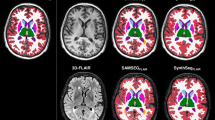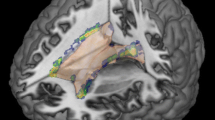Abstract
Purpose
Manual measures such as corpus callosum index, normalized corpus callosum area, and width of the third ventricle are potential biomarkers for brain atrophy. In this work, we investigate their suitability to assess the neurodegenerative component of multiple sclerosis (MS) by comparing them to volumetric measures and expanded disability status scale (EDSS).
Methods
Fifty-eight patients with a clinically isolated syndrome, 48 MS patients treated with interferon β, and 26 treated with natalizumab underwent a brain MRI at baseline and after 1 year. Manual measures were evaluated by two observers using Jim v.6.0 at both time points. Volumetric tools (SIENA/x and Freesurfer) were used to calculate normalized brain volume, brain parenchymal fraction, annualized percentage of brain volume change, corpus callosum volume, ventricle volume, and volume of the third ventricle. Statistical analyses were performed with SPSS v.13.
Results
Usage of corpus callosum volume and third ventricle volume to validate normalized corpus callosum area and width of the third ventricle, respectively, showed very good correlations (r = 0.85, r = 0.83; p < 0.01). Width of the third ventricle, corpus callosum index, and normalized corpus callosum area correlations were significant with EDSS in all patients and moderate to strong with normalized brain volume and brain parenchymal fraction in natalizumab-treated patients (respectively r = − 0.54, r = − 0.61; r = 0.55, r = 0.67; and r = 0.58, r = 0.67; with p < 0.05).
Conclusion
Width of the third ventricle and normalized corpus callosum area seem the more robust manual measures regarding correlation with volumetric measures and EDSS, especially in patients with more advanced disease.



Similar content being viewed by others
References
Rocca MA, Comi G, Filippi M (2017) The role of T1-weighted derived measures of neurodegeneration for assessing disability progression in multiple sclerosis. Front Neurol 8:488
Miller DH, Barkhof F, Frank JA, Parker GJ, Thompson AJ (2002) Measurement of atrophy in multiple sclerosis: pathological basis, methodological aspect and clinical relevance. Brain 125:1676–1695
Pérez-Miralles F, Sastre-Garriga J, Tintoré M, Arrambide G, Nos C, Perkal H et al (2013) Clinical impact of early brain atrophy in clinically isolated syndromes. Mult Scler 19:1878–1886
Fisher E, Lee JC, Nakamura K, Rudick RA (2008) Grey matter atrophy in multiple sclerosis: a longitudinal study. Ann Neurol 64:255–265
Fisniku LK, Chard DT, Jackson JS, Anderson VM, Altmann DR, Miszkiel KA, Thompson AJ, Miller DH (2008) Grey matter atrophy is related to long-term disability in multiple sclerosis. Ann Neurol 64:247–254
Roosendaal SD, Bendfeldt K, Vrenken H, Polman CH, Borgwardt S, Radue EW, Kappos L, Pelletier D, Hauser SL, Matthews PM, Barkhof F, Geurts JJ (2011) Grey matter volume in a large cohort of MS patients: relation to MRI parameters and disability. Mult Scler 17:1098–1106
Vaneckova M, Kalincik T, Krakensky J, Horakova D, Havrdova E, Hrebikova T, Seidl Z (2012) Corpus callosum atrophy- a simple predictor of multiple sclerosis progression: a longitudinal 9-year study. Eur Neurol 68:23–27
Arrambide G, Tintoré M, Auger C, Río J, Castilló J, Vidal-Jordana A et al (2017) Lesion topographies in multiple sclerosis diagnosis: a reappraisal. Neurology 89:2351–2356
Smith SM, Zhang Y, Jenkinson M, Chen J, Matthews PM, Federico A, De Stefano N (2002) Accurate, robust and automated longitudinal and cross-sectional brain change analysis. NeuroImage 17:479–489
Smith SM, Jenkinson M, Woolrich MW, Beckmann CF, Behrens TE, Johansen-Berg H et al (2004) Advances in functional and structural MR image analysis and implementation as FSL. NeuroImage 23:208–219
Patenaude B, Smith SM, Kennedy DN, Jenkinson M (2001) A bayesian model of shape and appearance for subcortical brain. NeuroImage 56:907–922
Fabiano AJ, Sharma J, Weinstock-Guttman B, Munschauer FE 3rd, Benedict RH, Zivadinov R, Bakshi R (2003) Thalamic involvement in multiple sclerosis: a diffusion-weighted magnetic resonance imaging study. J Neuroimaging 13:307–314
Bakshi R, Benedict RHB, Bermel RA, Caruthers SD, Puli SR, Tjoa CW, Fabiano AJ, Jacobs L (2002) T2 hypointensity in the deep grey matter of patients with multiple sclerosis: a quantitative magnetic resonance imaging study. Arch Neurol 59:62–68
Cifelli A, Arridge M, Jezzard P, Esiri MM, Palace J, Matthews PM (2002) Thalamic neurodegeneration in multiple sclerosis. Ann Neurol 52:650–653
Tintoré M, Rovira A, Río J, Otero-Romero S, Arrambide G, Tur C et al. (2015) Defining high, medium and low impact prognostic factors for developing multiple sclerosis. Brain 138:1863–74
Pérez-Miralles FC, Sastre-Garriga J, Vidal-Jordana A, Río J, Auger C, Pareto D et al. (2015) Predictive value of early brain atrophy on response in patients treated with interferon B. Neurol Neuroimmunol Neuroinflamm 2(4):e132. https://doi.org/10.1212/NXI.0000000000000132
Ciampi E, Pareto D, Sastre-Garriga J, Vidal-Jordana A, Tur C, Río J et al. (2017) Grey matter atrophy is associated with disability increase in natalizumab-treated patients. Mult Scler 23:556–66
Figueira FF, Santos VS, Figueira GM, Silva AC (2007) Corpus callosum index. Arq Neuropsiquiatr 65:931–935
Benedict RHB, Weinstock-Guttman B, Fishman I, Sharma J, Tjoa CW, Bakshi R (2004) Prediction of neuropsychological impairment in multiple sclerosis comparison of conventional magnetic resonance imaging measures of atrophy and lesion burden. Arch Neurol 61:226–230
Pareto D, Sastre-Garriga J, Aymerich FX, Auger C, Tintoré M, Montalban X, Rovira A (2016) Lesion filling effect in regional brain volume estimations: a study in multiple sclerosis patients with low lesion load. Neuroradiology 58:467–474
Portney LG, Watkins MP (2000) Foundations of clinical research: applications to practice. Prentice Hall, Upper Saddle River
Evans JD (1996) Straightforward statistics for the behavioural sciences. Pacifica Grove, CA
Yaldizli Ö, Atefy R, Gass A, Sturm D, Glassl S, Tettenborn B, Putzki N (2010) Corpus callosum index and long-term disability in multiple sclerosis patients. J Neurol 257:1256–1264
Granberg T, Martola J, Bergendal G, Shams S, Damangir S, Aspelin P (2015) Corpus callosum atrophy is strongly associated with cognitive impairment in multiple sclerosis: results of a 17-year longitudinal study. Mult Scler 21:1151–1158
Granberg T, Bergendal G, Shams S, Aspelin P, Kristoffersen-Wiberg M, Fredrikson S, Martola J (2015) MRI-defined corpus callosal atrophy in multiple sclerosis: a comparison of volumetric measurements, corpus callosum area and index. J Neuroimaging 25:996–1001
Klawiter EC, Ceccarelli A, Arora A, Jackson J, Bakshi S, Kim G, Miller J et al (2015) Corpus callosum atrophy correlates with grey matter atrophy in patients with multiple sclerosis. J Neuroimaging 25:62–67
Odenthal C, Simpson S Jr, Oughton J, van der Mei I, Rose S, Fripp J, Lucas R (2017) Midsagittal corpus callosum area and conversion to multiple sclerosis after clinically isolated syndrome: a multicentre Australian cohort study. J Med Imaging Radiat Oncol 61:453–460
Bjartmar C, Trapp BD (2001) Axonal and neuronal degeneration in multiple sclerosis: mechanisms and functional consequences. Curr Opin Neurol 14:271–278
Bjartmar C, Wujek JR, Trapp BD (2003) Axonal loss in the pathology of multiple sclerosis: consequences for understanding the progressive phase of the disease. J Neurol Sci 206:165–171
Evangelou N, Konz D, Esiri MM, Smith S, Palace J, Matthews PM (2000) Regional axonal loss in the corpus callosum correlates with cerebral white matter lesion volume and distribution in multiple sclerosis. Brain 123:1845–1849
Jänck L, Mérillat S, Liem F, Hänggi J (2015) Brain size, sex and the aging brain. Hum Brain Mapp 36:150–169
Confavreux C, Vukusic S, Adeleine P (2003) Early clinical predictors and progression of irreversible disability in multiple sclerosis: an amnesic process. Brain 126:770–782
Myhr KM, Riise T, Vedeler C, Nortvedt MW, Gronning R, Midgard R, Nyland HI (2001) Disability and prognosis in multiple sclerosis: demographic and clinical variables important for the ability to walk and awarding of disability pension. Mult Scler 7:59–65
De Stefano N, Matthews PM, Filippi M, Agosta F, De Luca M, Bartolozzi ML, Guidi L et al (2003) Evidence of early cortical atrophy in MS: relevance to white matter changes and disability. Neurology 60:1157–1162
Kassubek J, Tumani H, Ecker D, Kurt A, Ludolph AC, Juengling FD (2003) Age-related brain parenchymal fraction is significantly decreased in young multiple sclerosis patients: a quantitative MRI study. Neuroreport 14:427–430
Sharma J, Sanfilipo MP, Benedict RH, Weinstock-Guttman B, Munchauer FE 3rd, Bakshi R (2004) Whole-brain atrophy in multiple sclerosis measured by automated versus semiautomated MR imaging segmentation. Am J Neuroradiol 25:985–996
Tiberio M, Chard DT, Altmann DR, Davies G, Griffin CM, Rashid W, Sastre-garriga J et al (2005) Grey and white matter volume changes in early RRMS: a 2-year longitudinal study. Neurology 64:1001–1007
Quarantelli M, Ciarmiello A, Brescia Morra V, Orefice G, Larobina M, Lanzillo R, Schiavone V et al (2003) Brain tissue volume changes in relapsing-remitting multiple sclerosis: correlation with lesion load. Neuroimage 18:360–336
Immich Conçalves I, Rodrigues dos Passos G, Piccoli Conzatti L, Palmeiro Burger JL, Henrique Tomasi G, Édler Zandoná M, Schermann Azmbuja L et al (2018) Correlation between the corpus callosum index and brain atrophy, lesion load and cognitive dysfunction in multiple sclerosis. Mult Scler Relat Disord 20:154–158
Acknowledgements
The authors would like to thank L. Cockmartin from the Department of Radiology from the University Hospital Leuven for her support during the statistical analysis. A special thanks goes to all patients participated in the study.
Author information
Authors and Affiliations
Corresponding authors
Ethics declarations
Conflict of interest
S. Cappelle declares that she has no conflict of interest. D. Pareto has received a speaker honorarium from Novartis and Sanofi-Genzyme. M. Tintoré has received a speaker honorarium and travel expenses for participation in scientific meetings or advisory boards in past years from Almirall, Bayer, Biogen, EMD Serono, Genzyme, Merck, Novartis, Roche, Sanofi-Genzyme, Teva Pharmaceutical, VielaBio, and Excemed. A. Vidal-Jordana has received honoraria as speaker and/or for participation in Advisory Boards from Novartis, Roche, Sanofi-Genzyme, and Biogen. R. Alyafeai has been awarded the McDonald fellowship from MSIF. M. Alberich declares that he has no conflict of interest. J. Sastre-Garriga has received grants and personal fees from Genzyme, personal fees from Almirall, Biogen, Celgene, Merck, Novartis, Roche, and Teva. He declares being a member of the Editorial Committee of the MS Journal for which he receives a personal fee and Director of the Scientific Committee of Revista de Neurología, for which he does not receive any personal fee. C. Auger declares that she has no conflict of interest. X. Montalban has received a speaker honorarium and travel expenses for participation in scientific meetings or advisory boards in past years from Actelion, Alexion, Bayer, Biogen, Celgene, EMD Serono, Genzyme, Medday, Merck, Nervgen, Novartis, Roche, Sanofi-Genzyme, Teva Pharmaceutical, TG Therapeutics, Excemed, MSIF, and NMSS. A. Rovira has received a speaker honorarium from Bayer, Sanofi-Genzyme, Bracco, Merck-Serono, Teva Pharmaceutical Industries Ltd., Novartis, Roche, and Biogen. He serves on scientific advisory boards for Novartis, Sanofi-Genzyme, SyntheticMR, Bayer, Roche, Biogen, Neurodiem, and OLEA Medical.
Ethical approval
This study was in accordance with the ethical standards of the institutional and/or national research committee and with the 1964 Helsinki declaration and its later amendments or comparable ethical standards.
Informed consent
Informed consent was obtained from all individual participants included in the study.
Additional information
Publisher’s note
Springer Nature remains neutral with regard to jurisdictional claims in published maps and institutional affiliations.
Rights and permissions
About this article
Cite this article
Cappelle, S., Pareto, D., Tintoré, M. et al. A validation study of manual atrophy measures in patients with Multiple Sclerosis. Neuroradiology 62, 955–964 (2020). https://doi.org/10.1007/s00234-020-02401-3
Received:
Accepted:
Published:
Issue Date:
DOI: https://doi.org/10.1007/s00234-020-02401-3




